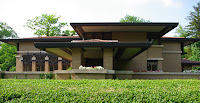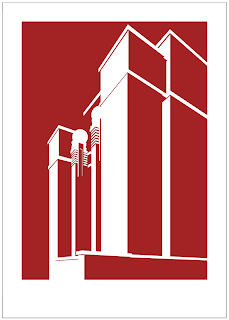As another year fades to black, it's time to reflect on what has been another busy one in the life of a Martin House curator. So here, in no particular order, are my Top Eleven Curatorial Moments of 2011.
And yes, for you Nigel Tufnel fans, this list does go up to eleven:
And yes, for you Nigel Tufnel fans, this list does go up to eleven:
11) Meeting legendary Taliesin photographer, Pedro Guerrero and his wife, Dixie, and touring them through the Martin House. Pedro has taken some of the most iconic photos of Frank Lloyd Wright, and his stories of his long association with the architect are equally vivid.
 10) Travelling with fellow Martin House staff and volunteers to Michigan to visit Saarinen's Cranbrook Academy, Wright's Affleck House, Turkel House, Meyer May and others. An added bonus in Grand Rapids was the opportunity to hang out with Martin grandson, Jerry Foster and his wife Hanne
10) Travelling with fellow Martin House staff and volunteers to Michigan to visit Saarinen's Cranbrook Academy, Wright's Affleck House, Turkel House, Meyer May and others. An added bonus in Grand Rapids was the opportunity to hang out with Martin grandson, Jerry Foster and his wife Hanne (on their turf, for a change).
 9) Assisting Rich Kegler of the Western New York Book Arts Collaborative in creating an ingenious image of the Martin House, formed entirely from metal and wood type and ornaments. These unique, limited edition prints are still available in the Wisteria Shop.
9) Assisting Rich Kegler of the Western New York Book Arts Collaborative in creating an ingenious image of the Martin House, formed entirely from metal and wood type and ornaments. These unique, limited edition prints are still available in the Wisteria Shop. 8) Welcoming two great speakers to the Martin House: David Patterson, who spoke on the fascinating topic of Wright and music, and Jonathan Massey, who introduced the intriguing life and work of Rochester-born designer Claude Bragdon. These guys will be hard acts to follow!
8) Welcoming two great speakers to the Martin House: David Patterson, who spoke on the fascinating topic of Wright and music, and Jonathan Massey, who introduced the intriguing life and work of Rochester-born designer Claude Bragdon. These guys will be hard acts to follow! 7) Receiving a beautiful carriage house art glass window from Buffalo collectors Will and Nan Clarkson. They miss it in their house, but are welcome to visit it in our house, any time they like.
7) Receiving a beautiful carriage house art glass window from Buffalo collectors Will and Nan Clarkson. They miss it in their house, but are welcome to visit it in our house, any time they like.6) The announcement of an extraordinarily generous gift of three pieces of Wright-designed furniture and a "Tree of Life" art glass window from the collection of the Albright-Knox Art Gallery. I wish we could reciprocate, but we're fresh out of Clyfford Stills...
 5) The return of a number of Martin House furnishings from the New York State Bureau of Historic Sites, just in time for the visit by the National Trust for Historic Preservation. The Preservation conference was a big success by all accounts, and folks say the furnished spaces of the house have never looked better.
5) The return of a number of Martin House furnishings from the New York State Bureau of Historic Sites, just in time for the visit by the National Trust for Historic Preservation. The Preservation conference was a big success by all accounts, and folks say the furnished spaces of the house have never looked better.
4) Installation of two precisely-reproduced tables (dining and library) from craftsman Tim Coleman. Tim clearly took a great deal of pride in his work, and the tables add an invaluable dimension to the unit room.
3) Giving a panel presentation with my NY State Parks conservator colleagues for the National Trust conference - a rare opportunity to showcase the close collaboration between the ivory tower and conservator's lab.
2) Presenting the ups and downs of the Weekly Wright-up to the Public Sites committee at the Frank Lloyd Wright Building Conservancy conference in Philadelphia. There was lots of interest in the potential that blogs and social media hold for Wright sites that want to stay relevant in the 21st century.
1) Substantial completion of Phase 5A of restoration in the Martin House. We now have state-of-the-art mechanical systems, new plaster throughout, restored or reproduced trim in the Reception room, restored floor tile, reproduction light fixtures and the re-installation of some art glass. We're so close to the finish line, you can almost touch it...
Here's to the year ahead!

 5) The return of a number of Martin House furnishings from the New York State Bureau of Historic Sites, just in time for the visit by the National Trust for Historic Preservation. The Preservation conference was a big success by all accounts, and folks say the furnished spaces of the house have never looked better.
5) The return of a number of Martin House furnishings from the New York State Bureau of Historic Sites, just in time for the visit by the National Trust for Historic Preservation. The Preservation conference was a big success by all accounts, and folks say the furnished spaces of the house have never looked better.4) Installation of two precisely-reproduced tables (dining and library) from craftsman Tim Coleman. Tim clearly took a great deal of pride in his work, and the tables add an invaluable dimension to the unit room.
3) Giving a panel presentation with my NY State Parks conservator colleagues for the National Trust conference - a rare opportunity to showcase the close collaboration between the ivory tower and conservator's lab.
2) Presenting the ups and downs of the Weekly Wright-up to the Public Sites committee at the Frank Lloyd Wright Building Conservancy conference in Philadelphia. There was lots of interest in the potential that blogs and social media hold for Wright sites that want to stay relevant in the 21st century.
1) Substantial completion of Phase 5A of restoration in the Martin House. We now have state-of-the-art mechanical systems, new plaster throughout, restored or reproduced trim in the Reception room, restored floor tile, reproduction light fixtures and the re-installation of some art glass. We're so close to the finish line, you can almost touch it...
Here's to the year ahead!







































